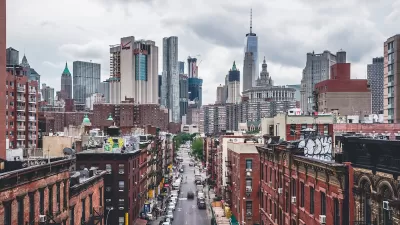Kio Stark, professor at NYU's Interactive Telecommunications Program explains lucidly how strangers and cities are "inherently intertwined."
"The everyday nature of interacting with stranger is a byproduct of urbanization, which has created a culture of dense populations with sparse interconnections," writes Stark. "Living in cities has made strangers into a multitude: we brush past thousands of them every day."
Now, with geolocation services like Foursquare and augmented reality applications on the horizon, what it means to be a stranger is becoming increasingly uncertain. Stark finds social behavior has a close relationship with public space, and the way people move through it. Indeed, she finds that there are "cognitive scientists who study the idea that perception, emotion, and attitudes are the processes of the body moving through space (rather than simply neural signals in the brain)."
FULL STORY: Stranger Studies 101: Cities As Interaction Machines

Alabama: Trump Terminates Settlements for Black Communities Harmed By Raw Sewage
Trump deemed the landmark civil rights agreement “illegal DEI and environmental justice policy.”

Planetizen Federal Action Tracker
A weekly monitor of how Trump’s orders and actions are impacting planners and planning in America.

The 120 Year Old Tiny Home Villages That Sheltered San Francisco’s Earthquake Refugees
More than a century ago, San Francisco mobilized to house thousands of residents displaced by the 1906 earthquake. Could their strategy offer a model for the present?

Indy Neighborhood Group Builds Temporary Multi-Use Path
Community members, aided in part by funding from the city, repurposed a vehicle lane to create a protected bike and pedestrian path for the summer season.

Congestion Pricing Drops Holland Tunnel Delays by 65 Percent
New York City’s contentious tolling program has yielded improved traffic and roughly $100 million in revenue for the MTA.

In Both Crashes and Crime, Public Transportation is Far Safer than Driving
Contrary to popular assumptions, public transportation has far lower crash and crime rates than automobile travel. For safer communities, improve and encourage transit travel.
Urban Design for Planners 1: Software Tools
This six-course series explores essential urban design concepts using open source software and equips planners with the tools they need to participate fully in the urban design process.
Planning for Universal Design
Learn the tools for implementing Universal Design in planning regulations.
Clanton & Associates, Inc.
Jessamine County Fiscal Court
Institute for Housing and Urban Development Studies (IHS)
City of Grandview
Harvard GSD Executive Education
Toledo-Lucas County Plan Commissions
Salt Lake City
NYU Wagner Graduate School of Public Service





























